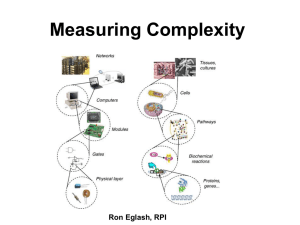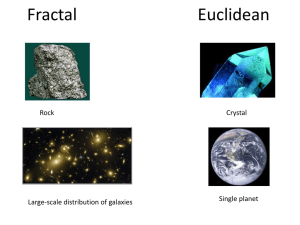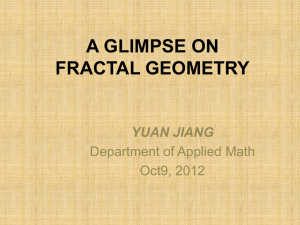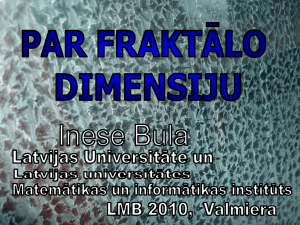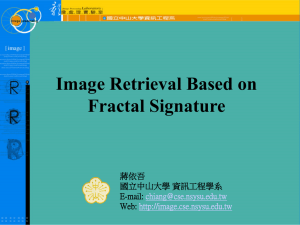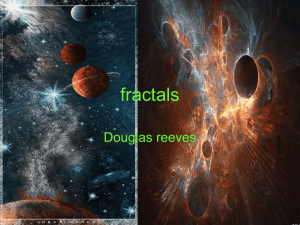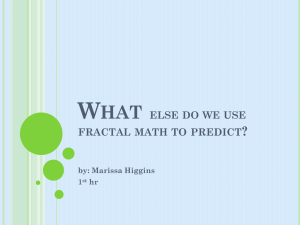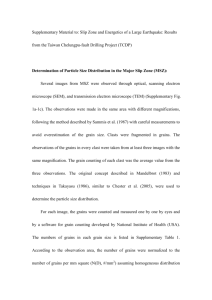Diagnosisofcervicalcellsbased onfractal and
advertisement
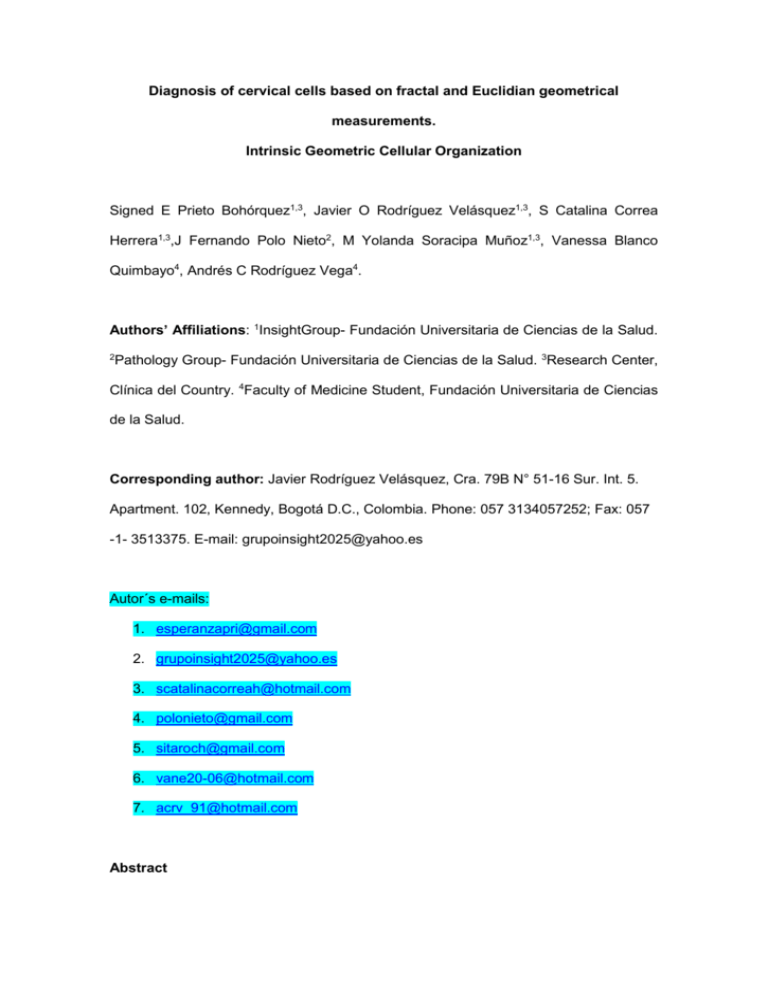
Diagnosis of cervical cells based on fractal and Euclidian geometrical measurements. Intrinsic Geometric Cellular Organization Signed E Prieto Bohórquez1,3, Javier O Rodríguez Velásquez1,3, S Catalina Correa Herrera1,3,J Fernando Polo Nieto2, M Yolanda Soracipa Muñoz1,3, Vanessa Blanco Quimbayo4, Andrés C Rodríguez Vega4. Authors’ Affiliations: 1InsightGroup- Fundación Universitaria de Ciencias de la Salud. 2 Pathology Group- Fundación Universitaria de Ciencias de la Salud. 3Research Center, Clínica del Country. 4Faculty of Medicine Student, Fundación Universitaria de Ciencias de la Salud. Corresponding author: Javier Rodríguez Velásquez, Cra. 79B N° 51-16 Sur. Int. 5. Apartment. 102, Kennedy, Bogotá D.C., Colombia. Phone: 057 3134057252; Fax: 057 -1- 3513375. E-mail: grupoinsight2025@yahoo.es Autor´s e-mails: 1. esperanzapri@gmail.com 2. grupoinsight2025@yahoo.es 3. scatalinacorreah@hotmail.com 4. polonieto@gmail.com 5. sitaroch@gmail.com 6. vane20-06@hotmail.com 7. acrv_91@hotmail.com Abstract Background: Fractal geometry has been the basis for the development of a diagnosis of preneoplastic and neoplastic cells that clears up the undetermination of the atypical squamous cells of undetermined significance (ASCUS). Objective: to develop a diagnostic methodology of cervix cytology based on fractal and Euclidean measures of the frontier and surface of the nucleus and cytoplasm, differentiating normal cells, ASCUS, Low-grade (L-SIL) and High-grade (H-SIL) squamous intraepithelial lesions. Methods: Pictures of 40 cervix cytology samples diagnosed with conventional parameters were taken. A blind study was developed in which the clinic diagnosis of 10 normal cells, 10 ASCUS, 10 L-SIL and 10 H-SIL was masked. Cellular nucleus and cytoplasm were evaluated in the generalized Box-Counting space, calculating the fractal dimension and number of spaces occupied by the frontier of each object. Further, number of pixels occupied by surface of each object was calculated. Later, the mathematical features of the measures were studied to establish differences or equalities useful for diagnostic application. Finally, the sensibility, specificity, negative likelihood ratio and diagnostic concordance with Kappa coefficient were calculated. Results: Simultaneous measures of the nuclear surface and the subtraction between the boundaries of cytoplasm and nucleus, lead to differentiate normality, L-SIL and HSIL. Normality shows values less than or equal to 735 in nucleus surface and values greater or equal to 161 in cytoplasm-nucleus subtraction. L-SIL cells exhibit a nucleus surface with values greater than or equal to 972 and a subtraction between nucleuscytoplasm higher to 130. L-SIL cells show cytoplasm-nucleus values less than 120. The rank between 120-130 in cytoplasm-nucleus subtraction corresponds to evolution between L-SIL and H-SIL. Sensibility and specificity values were 100%, the negative likelihood ratio was zero and Kappa coefficient was equal to 1. Conclusions: A new diagnostic methodology of clinic applicability was developed based on fractal and euclidean geometry, which is useful for evaluation of cervix cytology. Key Words: Diagnosis, Fractal, cervix cancer, cytology. Background Uterine cervical cancer is the second most common cancer in women worldwide and accounts for about 20% of all gynecological cancers [1]. It has a mortality comparable to breast cancer, with 250,000 deaths annually and about 500,000 new cases reported each year [2]. This disease can be prevented through the cervico-vaginal cytology (CCV), which can detect abnormal cervical tissue before it progresses to invasive cancer [3]. Its diagnosis in the early stages is very important [4,5] as it can be curable [6-8] and the prognosis of patients have a survival rate at 5 years above 90%, which makes the CCV an essential tool for reducing mortality [9]. CCV usually presents high specificity ranging from 80% to 98%, but it has sensitivity highly variable with rates between 45% and 85% [10]. A systematic review by Nanda and colleagues to assess the diagnostic accuracy of the CCV, found an average sensitivity of 51% and a specificity of 98% [11]. Also, false negatives are presented with a prevalence between 20% and 40% [12,13], with an average of 35.5% [14]. The CCV has also demonstrated a lower specificity for high grade intraepithelial lesions than for low-grade lesions [15]. The difficulties in achieving higher sensitivity and specificity values are largely associated to the fact that assessments are based on qualitative parameters, which involves intra and inter-observer discrepancies and difficulties to diagnose cells with characteristics close to the limits from one to another state. Even with the adequate samples and expert pathologists, the interobserver variability still reduces cytological diagnosis accuracy [16,17]. As a result of these problems, it has not been established a unified global assessment. Currently the most widely used system for reporting CCV is the Bethesda System [18], which presents a narrative report that includes all cytology aspects (hormonal, morphological and microbiological). This system for the determination of squamous epithelial cell abnormalities presents classifications such as the Atypical Squamous Cells of Undetermined Significance (ASCUS), the low-grade squamous intraepithelial lesion (L-SIL) and the high grade squamous intraepithelial lesion (H-SIL). The H-SIL state includes the states before known as moderate dysplasia, severe dysplasia and carcinoma in situ, or CIN 2 and CIN 3 [19]. ASCUS category was introduced to define more clearly the "gray zone" between benign and malignant lesions, being the category with the lowest inter-observer reproducibility and the greater diagnostic challenge [20-22]. Such problems in the objective measurement of the cellular structure, as well as other anatomical structures of the human body, is associated with failure to have methodologies based on objective and reproducible measures of its irregularity, in the clinical practice. Usually, when steps are performed to objectify medical observations, Euclidean geometry is used. However, it was developed for the measurement of regular figures such as lines, areas or volumes. It has been shown that the use of regular measurements in irregular objects may lead to paradoxical results [23]. For example, superimposing a unit of any length on the perimeter of a circle, an X measurement is obtained. If this unit is decreased, the final measurement of the perimeter will increase, but if increasingly smaller sizes are overlapped, perimeter values will tend to a single value. In contrast, when performing the same procedure on the plane from a coast to determine its length, the final length tends to infinity, showing its irrelevance to establish a single objective measure for an object irregular like this [23]. Fractal geometry was developed to measure the irregularity of the objects, with a dimensionless numerical measure called fractal dimension [23,24]. Methodologies for the determination of the fractal dimension depend on the type of object being measured. In the case of abstract fractals such as the Sierpinski triangle, the dimension of Haussdorff is used. The statistical fractals, characterized by frequency distributions hyperbolic presentation of the events that make up the system, are measured by the fractal dimension of Zipf / Mandelbrot. Structures that have overlapping parts, such as the anatomical structures of the human body and chaotic attractors, are evaluated with Box Counting dimension [24], which relates to the spatial occupation of an object at different scales. In order to develop objective and reproducible diagnostic measures, Rodriguez et al. have used fractal geometry in cervical cells, differentiating normality and L-SIL by means of the concepts of Intrinsic mathematical Harmony (IMH) and variability of the fractal dimension [25,26]. These concepts allow to evaluate objectively and quantitatively the cells classified as ASCUS, establishing if they have values close to normality or L-SIL, being able to overcome the difficulties caused by the use of qualitative parameters, such as the Bethesda system. Recently it has been developed methodologies to characterize different fractal structures from fractal and Euclidean simultaneous measures, allowing the differentiation between normality and disease with clinical application. Such is the case of a method in which all possible coronary arteries in the process of restenosis were calculated, from normality to total occlusion of the lumen [27], allowing to quantify the degree of development of restenosis and thus improving measurements made only with fractal geometry [28]. Similarly, a fractal-euclidean methodology allows to distinguish normal from abnormal erythrocytes, being useful for determining the viability of bags for transfusion developed [29]. Following this new research perspective, useful in medical practice, the objective of this work is to apply both euclidean and fractal geometries for the development of a diagnostic method of clinical application for preneoplastic and neoplastic lesions of the cervix. Materials and Methods Definitions Fractal: term derived from the Latin fractus, meaning broken, which was proposed by Benoit Mandelbrot to refer to a geometric object characterized by its structure, either fragmented or irregular, is repeated at different scales. This word is used as noun, meaning as irregular object or adjective, meaning the irregularity of an object [24]. More accurately, a fractal is by definition a set for which the Hausdorff/Besicovitch dimension strictly exceeds the topological dimension [30]. Fractal dimension: Numerical measure that evaluates the irregularity of an object. Mathematically the essential mathematical property of a fractal object is that its fractal dimension is a non-integer. There are different methods to calculate fractal dimensions, depending on the characteristics of the object being measured. In the case of wild fractals, such as cervical cells, the definition of Box-Counting dimension is used [24]. Box-Counting Dimension: The Box-Counting dimension allows to quantify the changes in the irregularity of an object at different scales, using grids of different sizes which are overlapped to the object, in order to count the spaces occupied by the measured object in the different grids [24]. D LogN (2 ( K 1) ) LogN (2 K ) N (2 ( K 1) ) Log Ecuation 1 2 Log 2 K 1 Log 2 K N (2 K ) Where: N: Number of squares containing the outline of the object. K: Level of partition in the grid. D: fractal dimension Object surface: Number of pixels occupied by each one of the objects defined in each cell (nucleus and cytoplasm). See figures 1 and 2. FIGURE 1, 2 and 3. Procedure Cervix cytology samples of 40 women between 20-55 years were selected from Pathology Department of Hospital San José. These samples show reports of normal cytology and different grades of lesion including carcinoma issued by an expert pathologist according to conventional parameters, where carcinoma cells are included in H-SIL classification [19]. Digital pictures of 10 normal cells, 10 ASCUS, 10 L-SIL and 10 H-SIL were taken from cervical smear on the glass slides which were observed via Leika DM-2500 optical microscope with a 100X zoom. The pictures were carried to a computer interface, in order to be analyzed through an image editor, masking the diagnostic conclusion of cytologies. A physical-mathematical induction was developed, starting from the evaluation of two defined mathematical objects, which are the nucleus and the cytoplasm without nucleus of each cell. For this purpose it was used a previously developed software where each picture is superimposed with two grids of 2 and 4 pixels. Next the fractal dimension of each defined object is calculated (see equation 1) and the number of squares occupied by the border of each object is quantified with grill of 2 pixels. Later, the number of pixels occupying the surface of the defined objects were calculated. Finally, mathematical equalities and differences were searched, looking for characteristics of normality and disease as well as the evolution states between normality and disease, developing the geometric diagnosis without knowledge of conventional diagnosis. Ethics Statement Present research was undertaken and it conforms to the provisions of Declaration of Helsinki in 1995, due to this methodology have a theoretical character based on noninvasive test previously prescribed. And the patient’s privacy, integrity and anonymity were protected. For those reasons, the local ethics committee was consulted and deemed the work exempt from needing full ethical approval. Consent Statement Because the present research have a theoretical character and is based on noninvasive test previously prescribed, informed consent was not necessary. Statistical Analysis After developing the physical and mathematical diagnostic parameters, the clinical diagnostic results from cytologies evaluated with Bethesda System by the expert were unmasked, which are taken as the Gold-Standard. Since the physical-mathematical diagnosis differentiate between normality and disease, for comparison with the Gold Standard, cells conventionally classified as L-SIL or H-SIL were listed within a single classification as sick, allowing to establish a contingency table 2 * 2 to compare the number of normal and pathological cases concordant and non-concordant. Then sensibility, specificity and negative likelihood ratio were calculated. The level of concordance between Gold-Standard and physical-mathematical diagnosis was evaluated through Kappa coefficient. The cells classified as ASCUS were excluded of the statistical analysis because they don't have a specific diagnosis of normality or disease from Gold-standard. However, starting from the physical-mathematical evaluations, diagnostic relations of these cells were sought respect to the normality and disease states in order to specify quantitative differentiations. Results Nucleus surface showed values between 299 and 735 pixels for normality; between 1283 and 4765 pixels for ASCUS; between 972 and 5564 pixels for L-SIL and between 520 and 2706 pixels for H-SIL. These values can differentiate normality, ASCUS and LSIL. However they do not differentiate normality and H-SIL (Tables 1 to 4). Measurements of the cytoplasm frontier were between 205 and 548 squares in the the grid of 2 pixel´s side; between 216 and 548 squares in the the grid of 2 pixel´s side for normal cells; between 205 and 545 squares in the the grid of 2 pixel´s side for ASCUS cells; between 229 and 526 squares in the the grid of 2 pixel´s side for L-SIL and between 93 and 212 squares in the the grid of 2 pixel´s side for H-SIL cells. Measures of the nucleus frontier presented values between 35 and 159 squares in the grid of 2 pixel´s side; normal cells showed values between 35 and 55 squares in the grid of 2 pixel´s side; ASCUS between 72 and 139 squares in the grid of 2 pixel´s side; the L-SIL between 69 and 159 squares in the grid of 2 pixel´s side and the H-SIL between 48 and 119 squares in the grid of 2 pixel´s side. Subtracting the measured values of the nucleus and cytoplasm frontiers showed values between 161 and 506 squares in the grid of 2 pixel´s side for normality, between 133 and 450 squares in the grid of 2 pixel´s side for ASCUS, 120 to 422 squares in the grid of 2 pixel´s side for L-SIL and between 35 and 130 squares in the grid of 2 pixel´s side for H-SIL. These measures of Substraction of Cytoplasm-Nucleus frontiers mathematically differentiate normal cells from the H-SIL. Additionally there is an overlap in the values of L-SIL and H-SIL, however when analyzing the results, it is found that only the No. 7 H-SIL cell has values within the range of L-SIL, showing the value of 130 squares in the grid of 2 pixel´s side, while the remaining H-SIL cells feature values less than or equal to 112 squares in the grid of 2 pixel´s side. Similarly, it is noted that only two LSIL cells show values within the range of H-SIL, corresponding to 120 and 121 squares in the grid of 2 pixel´s side respectively (Tables 3 and 4). In the conventional diagnostic classifications it is found a diffuse space or "gray area" between L-SIL and H-SIL classifications; with this methodology is mathematically possible to quantify all the evolution between normality and disease. All the ASCUS cells in this study behaved mathematically as L-SIL cells. The fractal dimensions of the objects were calculated and the results are shown in Table 5. Statistical analysis resulted in sensitivity and specificity of 100%, a likelihood ratio of negative zero, and a Kappa coefficient of 1. Mathematical-Physical Diagnosis Normal cells are characterized by nuclear surfaces less than or equal to 735 pixels and values greater than or equal to 161 squares in the grid of 2 pixel´s side in the rest of the frontiers Cytoplasm-Nucleus. L-SIL cells have values greater than or equal to 972 pixels on the nucleus surface and a value greater than 130 squares in the grid of 2 pixel´s side in the rest of CytoplasmNucleus frontiers. H-SIL cells are characterized by values less than 120 in the rest of Cytoplasm-Nucleus frontiers. The differentiation between L-SIL and H-SIL cells is done only with the subtraction of Cytoplasm-Nucleus frontiers. The range 120-130 squares in the grid of 2 pixel´s side in the subtraction of Cytoplasm-Nucleus frontiers corresponds to the evolution between LSIL and H-SIL cells. Discussion This is the first work in which a fractal and euclidean diagnosis of cervical cells, observed in cytologies ranging from normality to H-SIL, is done. This is a diagnostic tool with clinic applicability, that determine in an objective and reproducible way the lesion grade of evaluated cells. Quantitative differences were established between normality, L-SIL and H-SIL, quantifying the increase in lesion severity from measures of cellular occupation in generalized Box-Counting space. A mathematical order underlying to cellular structure in preneoplastic and neoplastic development was evidenced allowing overcoming reproducibility difficulties of the current classification systems such as Bethesda System. In order to determine the cellular state, the conventional classification methodologies use the observation of the nucleus and the cytoplasm [13,16], as well as the simultaneous observation of qualitative parameters; however, these show reproducibility problems [11,16,17,19]. This methodology allows quantifying in an objective way the increase of the nuclear frontier and surface realizing of its irregular character with fractal methods. The measure of the difference between nucleus-cytoplasm frontiers shows the stage in which the cell is, and besides quantifies how close it is to a higher severity stage. This is useful in the diagnostic discrimination of ASCUS cells because it can clarify how close they are to normality or disease, as well as their possible evolution. So, the diagnostic challenge of this qualitative classification [19-22] has been resolved by means of the underlying harmony to cellular structure that was shown in the established mathematical measures, allowing quantifying the differences and similarities of the cells even when the clinic diagnostics were masked. The confidence in a mathematical and geometric order gave birth to this reproducible and objective result, thus unifying the qualitative systems of cytology classification. The diagnostic capability of the developed method was possible thanks to the simplicity of the mathematical language, because it showed that it was a simple phenomenon in so far the problem was observed from a physical and mathematical perspective. Also it showed that the problem evaluation had been complicated because of the type of observation and the qualitative language used, which is based on classifications from conventional medicine. Is for this reason that, although there was evidence of the association between normality and disease to different relations among nucleus and cytoplasm dimensions, it was not possible to establish such differences due to descriptive and qualitative language of conventional medicine. From the mathematical language the phenomenon is observed as a totality and all the possibilities in the evolution process can be obtained without the use of qualitative classifications which lose the phenomenon generality. So, normality and disease are particular geometric states within the whole phenomenon, in the same way as theoretical physics, where a single mathematical expression includes a whole phenomenon. That is the case of the universal gravitation theory, or the development of predictions of clinical application with the dynamical systems theory applied to cardiology [31,32], where there are no classifications but mathematical proportions that explain the phenomenon. For this reason, this kind of perspective of research is independent of epidemiological and statistical considerations, focusing on universal proportions to account for the whole phenomenon, being applicable to each particular case, and not just a majority population. This type of physical-mathematical approach makes unnecessary to start from the study of many cases to achieve diagnostic conclusions applicable to clinic. The statistical analysis of this study to evaluate the diagnostic capability of method was performed in order to meet the current requirements of medical research, showing the best Concordance with the Gold Standard, with a sensitivity and specificity of 100%, a negative likelihood ratio of zero, and a Kappa coefficient of 1. ASCUS cells evaluated in this study didn’t show quantitative features of normality; however there is evidence [25,26] that is not always so. Is very important to develop applications of this method to a greater number of cells in order to confirm the obtained limits and thereby refine its clinic applicability. Nevertheless, because of the mathematical and theoretical character of this method, these limits can vary without affecting the general diagnosis. Box Counting dimension allows for a measure of how a structure changes its spatial occupancy at different scales, thus quantifying its irregularity. This is possible due to overlapping grids of different sizes on the measured objects and the count of the spaces occupied by the edge of the object in each grid. However, the value of fractal dimension, observed in isolation, is not sufficient to establish diagnostic differences [33]. This makes it necessary to include a new measure, in this case from Euclidean geometry, but in the context of Box Counting space, thus respecting the irregularity of the object. For this, the values of the nucleus and cytoplasm borders in the different scales were observed, which are a quantification of its length, constituting a Euclidean magnitude in a fractal context. From this same perspective quantification of the surface of the measured objects are performed. Based on this analysis the relevant values and scales to differentiate the states evaluated were established, finding that the surface evaluated in pixels and the subtraction cytoplasmic - borders -core grid will 2 pixels were adequate measures and scales to establish diagnostic differences. Thus, unlike other studies in medicine in which Euclidean geometry applies regardless of the irregularity of the object, in this work, simultaneous Euclidean and fractal measures are achieved. Such simultaneous measurement had already been applied in the analysis of coronary restenosis process and erythrocyte morphophysiology. In the first case it was demonstrated that although the fractal dimensions of the arterial layers allowed objectively differentiate normality and restenosis, it was not possible to quantify the degree of its development. In contrast, measurements of the surface in the context of space Box Counting allowed establishing the quantitative values of the restenotic progress [27]. In the second case, the fractal measures did not allow differentiation, while the simultaneous evaluation of the surface and the edge of the erythrocyte objectively and quantitatively differentiated normal and disease [29]. The developed method is more practical than the conventional ones because it is applicable to each particular case without depending on neither population analysis nor risk factors. Moreover, it is a quantitative method that makes itself more objective and reproducible compared with the current qualitative classifications. With this methodology it is possible to facilitate the creation and evaluation of more effective and economical public health policies [10,34,35]for a more detailed monitoring over time of patients with cytologies that present some kind of squamous epithelial cell abnormality. The determinism, based on causality, was the valid research method for any knowledge area during Newtonian Mechanics era; that method was challenged during the development of statistical mechanics [36], chaos [37], and Quantum theories [38]. Starting from those theories causality ceased to be the foundation for understanding the nature and its phenomena. From this non-causal chaotic-deterministic perspective, Prigogine [39] considers that there are only temporal windows for evaluating of phenomena. Following this line, the present methodology was developed from a point of view where cause-effect relations were not considered; this is why it is independent of external factors such as age, risk factors and any population analysis. Here, only the temporal windows of the cells are observed, revealing a harmonic order underlying to cell structure, thus establishing mathematical characteristics to differentiate among each one of the grades of intraepithelial lesions. According to the hypothesis of genetic cancer etiology, the tumors appear as a consequence of clonal expansion of a single cell with a genetic alteration, therefore implying a disruption of the nucleus for the tumoral development [40]. In this sense it might be thought that the obtained result supports this hypothesis, being based in a morphometric measurement of the nucleus alteration. However, regardless of the veracity of this statement, this methodology is based on a non-causal physical and mathematical thought, in the sense that establishes diagnostic differences independently of any consideration regards to the origin of cancer development. Thus, this type of measure is a field of research than can be useful for objective and quantitative evaluation of preneoplastic and neoplastic cells from other tissues. From this non-causal perspective, also there have been developed predictions and methodologies of diagnostic help in other areas of medicine. For example, in cardiology it have been developed a diagnosis of Holter based on entropy proportions of attractors, allowing to establish predictions of patients’ state and evolution in the Coronary Unit Care [31,41,42], as well as a diagnostic law that enables to establish the totality of possible cardiac dynamics [32]. It has been developed theories of peptides binding in immunology [43] and molecular biology too [44]. In the field of epidemics prediction, it has been developed predictions of malaria outbreaks in periods of three weeks in Colombia’s municipalities [45]. In infectology, recently it has been developed a prediction method of CD4 based on the leukocyte and lymphocyte counts in HIV patients [46,47]. Acknowledgements This paper is a result of the Project 71-3743-5, approved in the second convening of the 2012, and funded by Research Division of the Fundación Universitaria de Ciencias de la Salud – Hospital de San José, so we appreciate your support. Special thanks to Dr. Guillermo Sánchez, Director of Research Division; to Dr. Magda Alba, Coordinator of Post-graduate Research; to Dr. Carlos Escobar, Knowledge Manager; and to Yanubi Salgado, Coordinator of Internal Convening, by their support and confidence in the Insight Group. We also thank to Research Center of Clínica del Country, especially to Dr. Tito Tulio Roa, Director of Medical Education; to Dr. Alfonso Correa, Director of Research Center; to Dr. Jorge Ospina, Medical Director; to Dr. Lizbeth Ortiz, epidemiologist and to Silvia Ortiz, Chief Nurse of the Research Center, for their support to our work. Dedication To our children. Competing interests The authors declare that they have no competing interests. Authors' contributions SEP conceived the study, and participated in its design and coordination, JOR conceived the study, and participated in its design and coordination, SCC developed software and mathematical - fractal calculations and drafted the document, JFP participated in data recollection and its systematization, MYS participated in data recollection and its systematization, VB drafted the document and participated in mathematical calculations, ACR drafted the document and participated in mathematical calculations.All authors read and approved the final manuscript. References 1. Yang BH, Bray FI, Parkin DM, Sellors JW, Zhang ZF:Cervical cancer as a priority for prevention in different world regions: an evaluation using years of life lost. Int J Cancer 2004;109(3):418 – 24. 2. World Health Organization. International Agency for Research Center. Globocan 2008: Fact Sheets: Cervix uteri, Worldwide [Internet]. c 2008 [Update 2010; cited 2013 Jan 14]. Availablefrom: http://globocan.iarc.fr/factsheet.asp 3. Robbins S:Aparato genital femenino. In: Patología estructural y funcional. Edited by Robbins S.Madrid: McGraw-Hill Interamericana de España S.A.; 1996. p. 1156 – 60. 4. Manos MM, Kinney WK, Hurley LB, Sherman ME, Shieh-Ngai J, Kurman RJ, et al: Identifying women with cervical neoplasia: using human papillomavirus DNA testing for equivocal Papanicolaou results.JAMA 1999;281(17):1605 – 10. 5. Quinn M, Babb P, Jones J, Allen E:Effects of screening on incidence of and mortality from cancer of cervix in England: evaluation based on routinely collected statistics.BMJ 1999; 318(7188):904 – 8. 6. Saslow D, Runowicz CD, Solomon D, Moscicki AB, Smith RA, Eyre HJ, et al. American Cancer Society:American Cancer Society guideline for the early detection of cervical neoplasia and cancer. CA Cancer J Clin 2002;52:342 – 62. 7. Wright TC, Cox JT, Massad LS, Carlson J, Twiggs LB, Wilkinson EJ. S:2001 consensus guidelines for the management of women with cervical intraepithelial neoplasia.Am J Obstet Gynecol 2003;189:295 – 304. 8. Green JA, Kirwan JM, Tierney JF, Symonds P, Fresco L, Collingwood M, et al:Survival and recurrence after concomitant chemotherapy and radiotherapy for cancer of the uterine cervix: a systematic review and meta-analysis.Lancet 2001;358(9284):781 – 6. 9. Weiderpass E, Labrèche F:Malignant Tumors of the Female Reproductive System. Saf Health Work 2012;3(3):166 – 80. 10. Goldie SJ, Gaffikin L, Goldhaber-Fiebert JD, Gordillo-Tobar A, Levin C, Mahe C, et al:Cost-effectiveness of cervical cancer screening in five developing countries. N Engl JMed 2005;353: 2158–68. 11. Nanda K, McCrory DC, Myers ER, Bastian LA, Hasselblad V, Hickey JD, et al:Accuracy of the Papanicolaou test in screening for and follow-up of cervical cytologic abnormalities: a systematic review. Ann Intern Med 2000;132: 810 – 9. 12. Subramaniam A, Fauci JM, Schneider KE, Whitworth JM, Erickson BK, Kim K, et al:Invasive cervical cancer and screening: what are the rates of unscreened and underscreened women in the modern era?J Low Genit Tract Dis 2011;15:110 – 3. 13. National Institutes of Health:NIH Consensus Statement Online 1996 April 113[Internet]. c1996. [cited 2012 Jun 15]. Available from: http://consensus.nih.gov/1996/1996cervicalcancer102html.htm 14. Spence AR, Goggin P, Franco EL:Process of care failures in invasive cervical cancer: systematic review and metaanalysis.Prev Med 2007;45:93 – 106. 15. Scheiden R, Wagener C, Knolle U, Dippel W, Capesius C:Atypical glandular cells in conventional cervical smears: incidence and follow-up.BMC Cancer 2004;4:1 – 9. 16. Schmidt JL, Henriksen JC, McKeon DM, Savik K, Gulbahce HE, Pambuccian SE:Visual estimates of nucleus-to-nucleus ratios: can we trust our eyes to use the Bethesda ASCUS and L-SIL size criteria?Cancer 2008;114:287 – 93. 17. Geisinger KR, Vrbin C, Grzybicki DM, Wagner P, Garvin AJ, Raab SS:Interobserver variability in human papillomavirus test results in cervico vaginal cytologic specimens interpreted as atypical squamous cells.Am J ClinPathol. 2007;128:1010 – 4. 18. Dim CC:Towards improving cervical cancer screening in Nigeria: A review of the basics of cervical neoplasm and cytology.Niger J Clin Pract 2012;15:247 – 52. 19. Lacruz C:Nomenclatura de las lesiones cervicales (de Papanicolau a Bethesda 2001). Rev Esp Patol 2003;36:5 – 10. 20. Smith AE, Sherman ME, Scott DR, Tabbara SO, Dworkin L, Olson J, et al:Review of the Bethesda System atlas does not improve reproducibility or accuracy in the classification of atypical squamous cells of undetermined significance smears. Cancer 2000;90:201 – 6. 21. Stoler MH, Schiffman M:Atypical Squamous Cells of Undetermined Significance–Low-grade Squamous Intraepithelial Lesion Triage Study (ALTS) Group. Interobserver reproducibility of cervical cytologic and histologic interpretations: realistic estimates for the ASCUS-L-SIL Triage Study.JAMA 2001;285:1500 – 1505. 22. Lachman MF, Cavallo-Calvanese C:Qualification of atypical squamous cells of undetermined significance in an independent laboratory: is it useful or significant? Am J Obstet Gynecol 1998;179:421 – 9. 23. Mandelbrot B:How Long Is the Coast of Britain? Statistical Self-Similarity and Fractional Dimension. Science 1967; 156:636 – 38. 24. Peitgen O, Jürgens H, Dietmar S:Length area and dimension. Measuring complexity and scalling properties.In:Chaos and Fractals: New Frontiers of Science.Edited by Peitgen O, Jürgens H, Dietmar S. New York: Springer-Verlag; 1992. p. 183 – 228. 25. Rodríguez J:Nuevo método fractal de ayuda diagnóstica para células preneoplásicas del epitelio escamoso cervical.Rev UDCA Act & Div Cient 2011; 14(1):15 – 22. 26. Rodríguez J, Prieto S, Correa C, Posso H, Bernal P, Vitery S, et al:Generalización fractal de células preneoplásicas y cancerígenas del epitelio escamoso cervical de aplicación clínica. Rev Fac Med 2010;18(2):173 – 181. 27. Rodríguez J, Prieto S, Correa C, Polo F, Soracipa S, Blanco V, et al: Fractal and euclidean geometric generalization of normal and restenosed arteries: fractal and euclidean geometric generalization of arteries. J. Med. Med. Sci. 2013; 4(4): 174-180. 28. Rodríguez J, Prieto S, Correa C, Bernal PA, Puerta G, Vitery S, et al: Theoretical generalization of normal and sick coronary arteries with fractal dimensions and the arterial intrinsic mathematical harmony. BMC Medical Physics 2010, 10:1 – 6. 29. Correa C, Rodríguez J, Prieto S, Álvarez L, Ospino B, Munévar A, et al:Geometric diagnosis of erythrocyte morphophysiology: Geometric diagnosis of erythrocyte.J Med Med Sci2012; 3(11):715 – 720. 30. Mandelbrot, B: The fractal geometry of nature. Revised and enlarged edition. New York: W.H. Freeman and Co.; 1983. p. 15. 31. Rodríguez J:Entropía Proporcional de los Sistemas Dinámicos Cardiacos: Predicciones físicas y matemáticas de la dinámica cardiaca de aplicación clínica. Rev Colomb Cardiol 2010; 17(3): 115 – 129. 32. Rodríguez J, Correa C, Melo M, Domínguez, D, Prieto S, Cardona DM, et al: Chaotic cardiac law: Developing predictions of clinical application. J Med Med Sci 2013; 4: 79 – 84. 33. Rodríguez J, Prieto S, Ortiz L, Wiesner C, Díaz M, Correa C: Descripción matemática con dimensiones fractales de células normales y con anormalidades citológicas de cuello uterino. Revista Ciencias de la Salud. 2006; 4 (2): 58-63. 34. Goldie SJ, Kim JJ, Myers E:Cost-effectiveness of cervical cancer screening. Vaccine 2006; 24:S164-S170. 35. Vanni T, Legood R, Franco EL, Villa L, Mendes P, Schwartsmann G:Economic evaluation of strategies for managing women with equivocal cytological results in Brazil.Int J Cancer 2011; 129: 671 – 9. 36. Feynman R:Los principios de la mecánica estadística.In:Física. Vol. 1. Edited by Feynman R. Wilmington: Addison-Wesley Iberoamericana S.A.; 1987. p. 40-1 – 4015. 37. Crutchfield J, Farmer D, Packard N, Shaw R:Caos. In: Orden y Caos. Edited by Crutchfield J, Farmer D, Packard N, Shaw R. Scientific American. Barcelona: Prensa Científica S.A.; 1990. p. 78 – 90. 38. Feynman R. Leighton RB, Sands M:Comportamiento cuántico. In: Física.Vol 1. Edited by Feynman R. Leighton RB, Sands M. Wilmington: Addison-Wesley Iberoamericana S.A.; 1987. p. 37-1 – 37-16. 39. Fernández-Rañada A:Introducción. In:Orden y Caos.Edited by FernándezRañada A. Barcelona: Scientific American. Prensa Científica S.A.; 1990. p. 4 – 8. 40. De Vita V, Hellman S, Rosenberg S:Cáncer: Principios y práctica de oncología. Madrid: Editorial Médica Panamericana y ARAN ediciones S.A.; 1997. 41. Rodríguez J. Proportional Entropy applied to the Clinic Prediction of Cardiac Dynamics.ICI Meeting 2012. Tel Aviv, Israel, 2012. 42. Rodríguez J, Prieto S, Domínguez D, Melo M, Mendoza F, Correa C, Soracipa Y, Pinilla L, Pardo J, Ramírez N:Mathematical-physical prediction of cardiac dynamics using the proportional entropy of dynamic systems. J Med MedSci 2013; 4(9):370-381. 43. Rodríguez J, Bernal P, Correa C, Prieto S, Benítez L, Vitery S, et al:Predicción de unión de péptidos de MSA-2 y AMA-1 de Plasmodium Falciparum al HLA clase II. Inmunología 2009; 28(3):115 – 124. 44. Rodríguez J, Bernal P, Prieto S, Correa C:Teoría de péptidos de alta unión de malaria al glóbulo rojo. Predicciones teóricas de nuevos péptidos de unión y mutaciones teóricas predictivas de aminoácidos críticos.Inmunología 2010; 29(1):7 – 19. 45. Rodríguez J:Método para la predicción de la dinámica temporal de la malaria en los municipios de Colombia. Rev Panam Salud Pública 2010;27(3):211 – 8. 46. Rodríguez J, Prieto S, Correa C, Forero M, Pérez C, Soracipa Y, Mora J, Rojas N, Pineda D, López F:Teoría de conjuntos aplicada al recuento de linfocitos y leucocitos: predicción de linfocitos T CD4 de pacientes con VIH/SIDA. Inmunología2013; 32(2): 50-56. 47. Rodríguez J, Prieto S, Correa C, Mora J, Bravo J, Soracipa Y, Álvarez L: Predictions of CD4 lymphocytes’ count in HIV patients from complete blood count. BMC Medical Physics. 2013; 13:3. Table 1. Measurements of the normal cells. The frontier is expressed in number of squares in the grill of 2 pixels, and the surface in pixels. Nucleus Subtraction of Citoplasm Cytoplasm- Cell Frontier Surface Frontier Nucleus frontiers 1 35 299 420 385 2 39 325 400 361 3 41 355 487 446 4 41 340 389 348 5 42 336 502 460 6 42 349 485 443 7 42 367 548 506 8 43 352 362 319 9 45 413 523 478 10 55 735 216 161 Table 2. Measures of the ASCUS cells.The frontier is expressed in number of squares in the grill of 2 pixels, and the surface in pixels. Nucleus Subtraction of Citoplasm Cytoplasm- Cell Frontier Surface Frontier Nucleus frontiers 1 72 1283 205 133 2 79 1530 476 397 3 86 1773 485 399 4 87 1887 355 268 5 95 2318 545 450 6 99 2151 482 383 7 104 2449 430 326 8 107 2776 322 215 9 129 4023 462 333 10 139 4765 479 340 Table 3. Measures of the L-SIL cells. The frontier is expressed in number of squares in the grill of 2 pixels, and the surface in pixels. Nucleus Subtraction of Citoplasm Cytoplasm- Cell Frontier Surface Frontier Nucleus frontiers 1 69 972 301 232 2 100 2406 413 313 3 104 2306 526 422 4 107 2311 418 311 5 109 2833 229 120 6 114 2883 235 121 7 124 3385 330 206 8 141 4057 334 193 9 159 5564 439 280 10 127 2936 290 163 Table 4. Measures of the H-SIL cells. The frontier is expressed in number of squares in the grill of 2 pixels, and the surface in pixels. Nucleus Subtraction of Citoplasm Cytoplasm- Cell Frontier Surface Frontier Nucleus frontiers 1 48 686 160 112 2 51 666 160 109 3 53 520 93 40 4 68 952 142 74 5 77 1194 129 52 6 78 1356 113 35 7 82 1458 212 130 8 97 2231 169 72 9 119 2706 174 55 10 63 870 120 57 Table 5. Minimum (MIN) and maximum (MAX) fractal dimensions found in each group for the measured objects. N: Nucleus. C: Citoplasm. T. Total object. FRACTAL DIMENSION Dx. N C T MIN 0,8590 0,9547 0,9607 MAX 1,0984 0,9943 1,0085 MIN 0,9316 0,9342 0,9591 MAX 0,9717 1,0249 1,0203 MIN 0,9235 0,9631 0,9603 MAX 1,0305 1,0155 1,0659 MIN 0,9229 0,9123 1,0438 MAX 1,1460 1,0570 1,2674 NORMAL ASCUS L-SIL H-SIL
